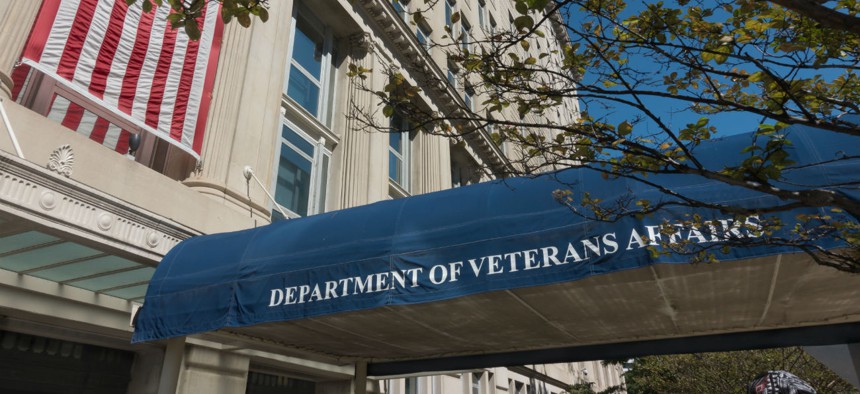
By bakdc / Shutterstock.com
Higher Pay and Parental Leave Could Help VA Address Vacancies, Official Says
Administration officials at multiple agencies acknowledge shortfalls in medical staffing.
Veterans Affairs Department officials told lawmakers on Wednesday their human resources systems are too complicated, and asked Congress for assistance in creating incentives that will help retain employees through paid parental leave programs and an easier pay adjustment process.
A high number of vacancies at VA is hurting the department and the veterans it serves, multiple watchdogs told the House Veterans' Affairs Committee, citing a lack of planning, inadequate pay and poor workforce data as the driving forces behind the unfilled jobs. VA officials noted the department's workforce has grown by 100,000 employees over the last decade and described improvements to hiring and retention efforts, but conceded VA must do more to address 49,000 current vacancies.
Daniel Sitterly, VA’s assistant secretary for human resources and administration, said the department doled out more than $50 million in “three-R” incentive payments in fiscal 2018, adding the bonuses for recruitment, relocation and retention helped “close skills gaps and provide greater flexibility” in bringing on and keeping “highly qualified VA professionals.” He lamented, however, that VA has 120 different hiring authorities and 60 different pay tables. The department, in conjunction with the Office of Personnel Management, is constantly reforming pay structures in various locations, but each update requires an overhaul of its IT systems.
“I would like very much to work with you and this committee and others to streamline those authorities to something simpler than that,” Sitterly told Rep. Mark Takano, D-Calif., the committee's chairman.
Sitterly also asked for Congress to authorize a pilot program in which VA could offer paid parental leave to its employees, calling it a “great incentive for retention.” House Democrats have renewed their efforts to institute the benefit across the federal workforce after failing for years to adopt the reform.
Sitterly suggested VA have more authority to set higher pay rates in areas where it cannot compete with local markets and said the department should reclassify its housekeeper positions to enable better pay rates. He highlighted the department's efforts at recruiting military spouses to VA positions and a direct hiring campaign that led, in part, to a 36% increase last year in veteran hires. Overall, however, he urged lawmakers not to micromanage the department.
“I would ask Congress to do a little less,” Sitterly said. “I have worked in human resources for 43 years and I have never seen a system so complex.” He added the best skill an HR employee can have is a law degree.
Absent real efforts to reduce its staffing shortfalls, Takano said, VA would be forced to send more veterans to the private sector for care. VA’s community partners are not equipped for an influx of veteran patients, the chairman warned.
“This is the wrong path for VA and most assuredly the wrong path for veterans,” Takano said.
The concern was bipartisan, as Rep. Phil Roe, R-Tenn., said that while there were some positive signs at VA, the department had to address its vacancies.
“Serious recruitment and retention problems remain for the department,” Roe said.
Among the issues highlighted by VA Inspector General Mike Missal and Government Accountability Office Director of Strategic Issues Robert Goldenkoff was the department’s failure to track its workforce needs. A measure Trump signed into law in 2018 required VA to publicly post its vacancy data each quarter, but Missal said that information has been consistently inaccurate. Goldenkoff said a forthcoming GAO report will show that due to high rates of turnover at the top ranks, VA has not issued a succession plan since 2009.
“VA's inability to adequately recruit, onboard and retain clinicians and support staff, particularly within specific service areas, reflects problems with competitive pay, field-wide shortages with some professions or positions, leadership and climate, planning and other factors,” Missal said in his prepared remarks. “Efforts to remediate these problems are hampered by VA’s inability to maintain accurate medical facility vacancy numbers.”
Goldenkoff called the vacancy issues “systemic, longstanding and harmful to VA’s mission.”
Sitterly vowed to address the inadequate vacancy data, acknowledging the department cannot use its statistics to actually address personnel needs. He took responsibility for the issue and said his office is working on a solution.
Elsewhere on Capitol Hill on Wednesday, the Health and Human Services Department lamented its own struggle to bring on health care clinicians. Its inspector general last month issued a scathing report attributing the HHS Office of Refugee Resettlement’s failure to provide adequate mental health services for migrant children at its contracted facilities in part to staffing shortfalls. Jonathan Hayes, the refugee office director, said his agency has taken a variety of steps to recruit more clinicians. Those efforts were hampered, however, because he was recruiting in difficult areas in the Southwest and because of the current political atmosphere.
Office of Refugee Resettlement job fairs have been subject to protestors and job applicants were “verbally assaulted,” Hayes said, “so that is not helpful.”
NEXT STORY: Pay Raise Battle Lines Drawn, and More







